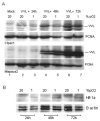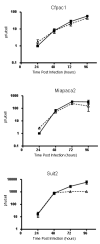Lister strain vaccinia virus, a potential therapeutic vector targeting hypoxic tumours
- PMID: 19890355
- PMCID: PMC2875103
- DOI: 10.1038/gt.2009.132
Lister strain vaccinia virus, a potential therapeutic vector targeting hypoxic tumours
Abstract
Hypoxia contributes to the aggressive and treatment-resistant phenotype of pancreatic ductal adenocarcinoma. Oncolytic vaccinia virus has potential as an anti-tumour agent, but the ability to lyse hypoxic tumour cells is vital for clinical efficacy. We hypothesized that unique aspects of the poxvirus life cycle would protect it from attenuation in hypoxic conditions. We characterized and compared the viral protein production, viral replication, cytotoxicity and transgene expression of Lister strain vaccinia virus in a panel of pancreatic cancer cell lines after exposure to normoxic or hypoxic conditions. Viral protein production was not affected by hypoxia, and high viral titres were produced in both normoxic and hypoxic conditions. Interestingly, there was a 3.5-fold (P<0.001) and 20-fold (P<0.0001) increase in viral cytotoxicity for CFPac1 and MiaPaca2 cell lines, respectively, in hypoxic conditions. Cytotoxicity was equivalent in the remaining cell lines. Levels of transgene expression (luciferase reporter gene) from the vaccinia viral vector were comparable, regardless of the ambient oxygen concentration. The present study suggests that the vaccinia virus is a promising vector for targeting pancreatic cancer and potentially other hypoxic tumour types.
Figures





Similar articles
-
Lister vaccine strain of vaccinia virus armed with the endostatin-angiostatin fusion gene: an oncolytic virus superior to dl1520 (ONYX-015) for human head and neck cancer.Hum Gene Ther. 2011 Sep;22(9):1101-8. doi: 10.1089/hum.2010.172. Epub 2011 Apr 18. Hum Gene Ther. 2011. PMID: 21361787
-
Oncolytic efficacy of thymidine kinase-deleted vaccinia virus strain Guang9.Oncotarget. 2017 Jun 20;8(25):40533-40543. doi: 10.18632/oncotarget.17125. Oncotarget. 2017. PMID: 28465492 Free PMC article.
-
Characterization of Oncolytic Vaccinia Virus Harboring the Human IFNB1 and CES2 Transgenes.Cancer Res Treat. 2020 Jan;52(1):309-319. doi: 10.4143/crt.2019.161. Epub 2019 Aug 6. Cancer Res Treat. 2020. PMID: 31401821 Free PMC article.
-
Progress in gene therapy using oncolytic vaccinia virus as vectors.J Cancer Res Clin Oncol. 2018 Dec;144(12):2433-2440. doi: 10.1007/s00432-018-2762-x. Epub 2018 Oct 6. J Cancer Res Clin Oncol. 2018. PMID: 30293118 Review.
-
Vaccinia virus, a promising new therapeutic agent for pancreatic cancer.Immunotherapy. 2015;7(12):1249-58. doi: 10.2217/imt.15.90. Epub 2015 Nov 23. Immunotherapy. 2015. PMID: 26595180 Free PMC article. Review.
Cited by
-
Oncolytic Viruses Engineered to Enforce Leptin Expression Reprogram Tumor-Infiltrating T Cell Metabolism and Promote Tumor Clearance.Immunity. 2019 Sep 17;51(3):548-560.e4. doi: 10.1016/j.immuni.2019.07.003. Epub 2019 Aug 27. Immunity. 2019. PMID: 31471106 Free PMC article.
-
A systemically deliverable Vaccinia virus with increased capacity for intertumoral and intratumoral spread effectively treats pancreatic cancer.J Immunother Cancer. 2021 Jan;9(1):e001624. doi: 10.1136/jitc-2020-001624. J Immunother Cancer. 2021. PMID: 33500259 Free PMC article.
-
Modifying oncolytic virotherapy to overcome the barrier of the hypoxic tumor microenvironment. Where do we stand?Cancer Cell Int. 2022 Nov 24;22(1):370. doi: 10.1186/s12935-022-02774-w. Cancer Cell Int. 2022. PMID: 36424577 Free PMC article. Review.
-
Vascular endothelial growth factor A promotes vaccinia virus entry into host cells via activation of the Akt pathway.J Virol. 2013 Mar;87(5):2781-90. doi: 10.1128/JVI.00854-12. Epub 2012 Dec 26. J Virol. 2013. PMID: 23269798 Free PMC article.
-
An effective therapeutic regime for treatment of glioma using oncolytic vaccinia virus expressing IL-21 in combination with immune checkpoint inhibition.Mol Ther Oncolytics. 2022 Jun 6;26:105-119. doi: 10.1016/j.omto.2022.05.008. eCollection 2022 Sep 15. Mol Ther Oncolytics. 2022. PMID: 35795092 Free PMC article.
References
-
- Harris AL. Hypoxia--a key regulatory factor in tumour growth. Nat Rev Cancer. 2002;2:38–47. - PubMed
-
- Hiley CT, Green MML, Shanks JH, Bottomley IC, West CML, Cowan RA, et al. Expression of vascular endothelial growth factor (VEGF) in locally invasive prostate cancer is prognostic for radiotherapy outcome. International journal of radiation oncology, biology, physics. 2007;67:84–90. - PubMed
-
- Hutchison GJ, Valentine HR, Loncaster JA, Davidson SE, Hunter RD, Roberts SA, et al. Hypoxia-inducible factor 1alpha expression as an intrinsic marker of hypoxia: correlation with tumor oxygen, pimonidazole measurements, and outcome in locally advanced carcinoma of the cervix. Clinical cancer research : an official journal of the American Association for Cancer Research. 2004;10:8405–8412. - PubMed
-
- Ghaneh P, Costello E, Neoptolemos JP. Biology and management of pancreatic cancer. Postgrad Med J. 2008;84:478–497. - PubMed
-
- Koong AC, Mehta VK, Le QT, Fisher GA, Terris DJ, Brown JM, et al. Pancreatic tumors show high levels of hypoxia. International journal of radiation oncology, biology, physics. 2000;48:919–922. - PubMed
Publication types
MeSH terms
Substances
Grants and funding
LinkOut - more resources
Full Text Sources
Other Literature Sources

